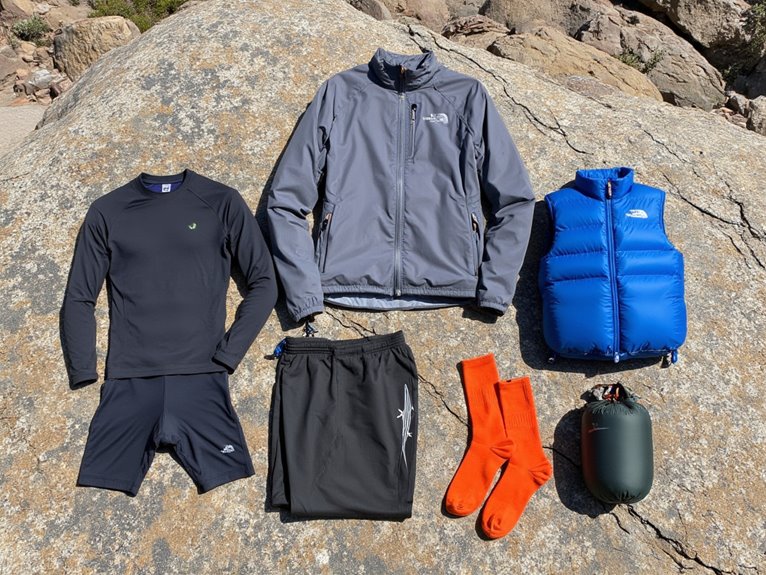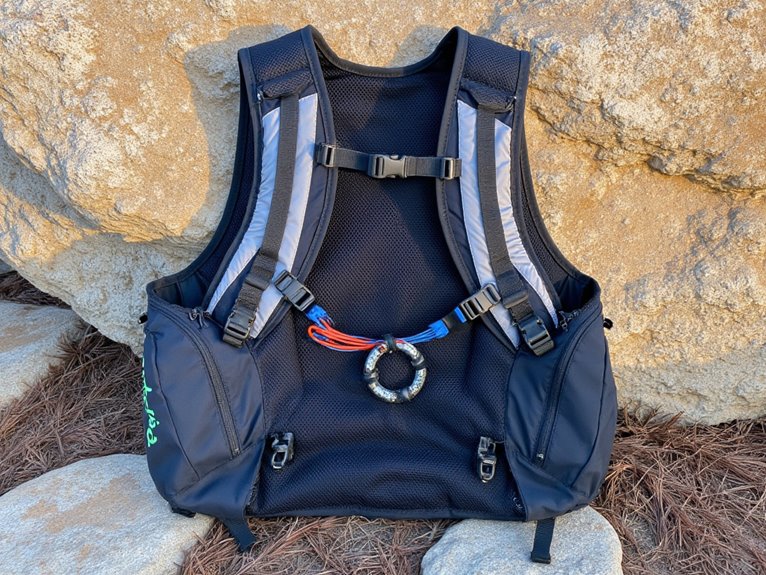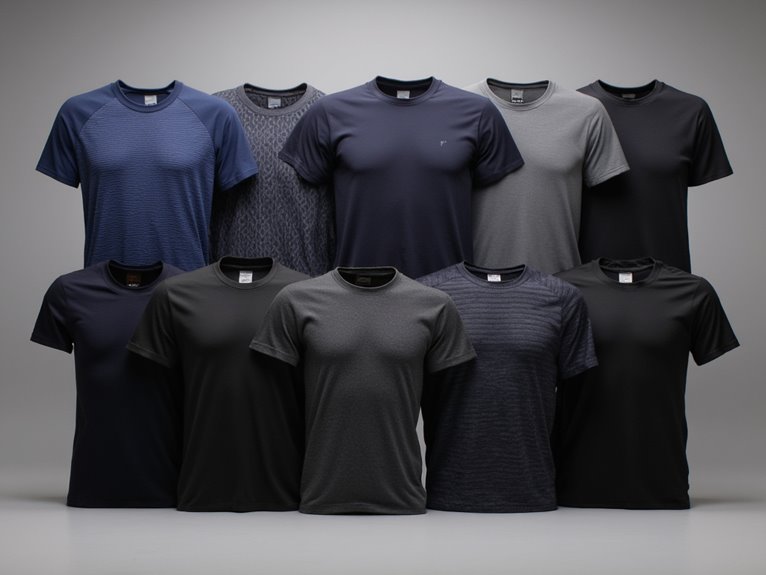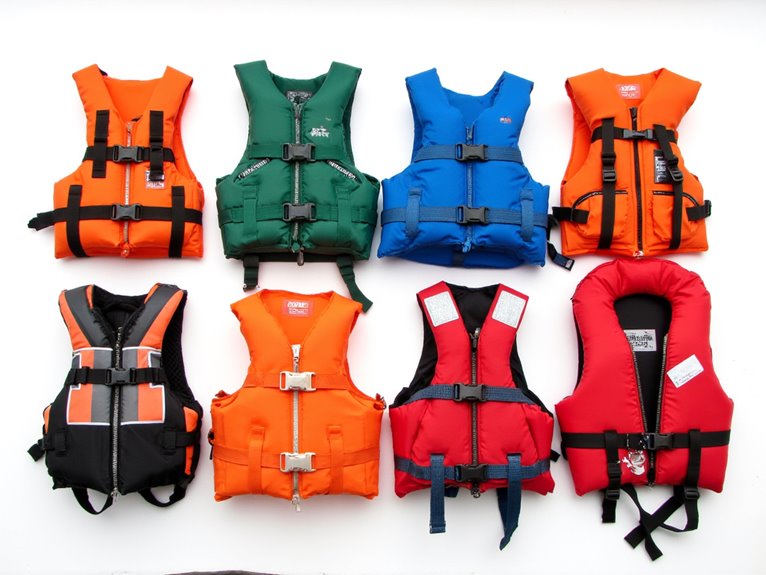Fastpacking Essentials: Running Gear That Works for Hiking
You’ll need trail running shoes instead of boots for weight savings and speed, paired with moisture-wicking base layers and 950-fill down insulation. Your “Big Three” – shelter, sleep system, and pack – should total under 10 pounds, with single-wall tents below 2 pounds and quilts for temperature efficiency. Choose running vest-style harnesses for better weight distribution and 20-30 liter capacity for multi-day trips. Carbon fiber trekking poles reduce knee strain while emergency gear stays minimal yet thorough for safety scenarios that demand strategic gear selection.
We are supported by our audience. When you purchase through links on our site, we may earn an affiliate commission, at no extra cost for you. Learn more. Last update on 6th January 2026 / Images from Amazon Product Advertising API.
Notable Insights
- Trail running shoes are preferred over hiking boots for fastpacking due to lighter weight and modern cushioning that reduces fatigue.
- Running vest-style harnesses distribute weight across chest and shoulders, improving balance while reducing back strain compared to traditional backpacks.
- Ultralight clothing systems using moisture-wicking base layers and 950-fill down insulation keep total weight under two pounds for optimal performance.
- Lightweight trekking poles made from carbon fiber reduce lower extremity stress while increasing walking speed without raising perceived exertion.
- Single-compartment ultralight packs under 10 pounds with 20-30 liter capacity provide adequate storage while maintaining fastpacking mobility and speed.
Trail-Running Shoes vs. Hiking Boots for Multi-Day Adventures
When you’re planning multi-day adventures that prioritize speed and distance over traditional backpacking, your footwear choice becomes critical to success.
Trail running shoes deliver significant weight advantages over hiking boots, reducing fatigue during extended miles. Modern cushioning technology in trail runners provides adequate protection while maintaining flexibility for natural foot movement.
However, weight trade offs come with compromises. Hiking boots offer superior ankle support and durability, lasting 700-800 miles versus 300-500 miles for trail runners.
Grip performance varies by design-trail runners excel at faster paces but may underperform on technical terrain where boots provide better stability.
Terrain adaptability determines your best option. Choose trail running shoes for packed trails and speed-focused objectives.
Select boots for heavy loads and challenging conditions.
Most trail running shoes provide a typical lifespan of 6-8 months under regular use, making proper care essential for extending their longevity during multi-day fastpacking adventures.
Ultralight Clothing Systems for Speed and Comfort

As fastpacking demands push you to cover greater distances with minimal gear, your clothing system becomes the most critical factor in maintaining speed without sacrificing protection.
Base layer benefits include moisture-wicking synthetic or merino wool fabrics that prevent chafing during extended movement.
Moisture-wicking synthetics and merino wool base layers eliminate chafing while maintaining thermal regulation during high-output fastpacking sessions.
Insulation layer options center on 950-fill down jackets providing ideal warmth-to-weight ratios.
Shell layer features must include high breathability ratings like 56k with 20k waterproofing for superior weather protection.
Layering principles focus on multifunctional garments under two pounds total.
Moisture management techniques incorporate pit zips and quick-drying materials.
Comfort enhancements include microfleece linings and seam taping.
Fit parameters demand close-to-body designs with stretch fabrics for unrestricted movement.
Your system balances 30-70 denier durability with ultralight construction for speed.
Overnight fastpacking requires sleeping bags that compress to 11-14 inches while maintaining the 1-3 pound weight target essential for maintaining your running pace.
The Big Three: Shelter, Sleep, and Pack Weight Optimization
Your clothing system won’t matter if you’re carrying a 40-pound pack with a 5-pound tent and bulky sleeping bag. The “Big Three” gear categories-shelter, sleep system, and pack-demand ruthless weight optimization for fastpacking success.
Target sub-2-pound shelters like the Mountain Laurel Designs SoloMid XL or Zpacks Duplex Lite. Trekking pole-compatible designs eliminate dedicated tent poles, reducing overall weight.
Sleep system integration requires quilts over sleeping bags; the Enlightened Equipment Enigma 30 weighs just 15.4 oz with 950-fill down.
Essential shelter features for fastpacking:
- Single-wall construction minimizes weight
- Trekking pole compatibility eliminates extra poles
- Quick setup/breakdown for time efficiency
- Weather protection without bulk penalty
- Compact pack size for streamlined carrying
The best ultralight backpacking tents achieve 3000mm-4000mm waterproof ratings while maintaining weights between 3.75 to 4.6 pounds for optimal protection without compromising speed.
Ultralight packs like the Zpacks Nero Ultra 38 weigh 10 oz, supporting base weights under 10 pounds.
Choosing the Right Capacity and Design for Fastpacking Packs
How do you determine the ideal pack size when every ounce matters and running efficiency can’t be compromised? Your capacity selection depends on trip duration and environmental conditions. For single-day adventures, 25 liters or less maintains maximum running ability. Multi-day trips require 28–30 liters as the sweet spot for essential gear.
| Trip Duration | Recommended Capacity | Key Considerations |
|---|---|---|
| 1 Day | 20-25L | Maximum running efficiency |
| 2-3 Days | 28-30L | Quilt, tarp, food supplies |
| 4-5 Days | 35L | Increased food/water weight |
| Desert Conditions | 30L+ | Extra water storage needed |
| Cold Weather | 30L+ | Additional insulation layers |
Pack organization features include multiple external pockets for quick access to snacks and hydration. Single-compartment designs reduce weight but sacrifice organization. Multiple pockets add functionality but increase overall pack weight by 2-6 ounces. Unlike traditional camping backpacks that range from 40L for day trips to 75L for extended adventures, fastpacking requires significantly smaller capacity ranges to maintain running performance.
Running Vest-Style Harnesses for Weight Distribution

While traditional backpacks rely on padded shoulder straps and substantial hip belts, running vest-style harnesses revolutionize weight distribution through a body-hugging design that transforms your torso into an integrated carrying system.
These frameless designs distribute 3.5 to 5 pounds across your chest and shoulders, reducing back strain considerably. The vest harness benefits include superior breathability, minimal bounce, and enhanced agility compared to traditional S-strap systems.
Key vest harness benefits include:
- Wide shoulder straps that contour naturally to your torso
- Multiple front pockets for strategic weight placement
- Reduced padding for lighter weight and better ventilation
- Load distribution across chest rather than concentrated on back
- Enhanced stability during running movements
Effective gear packing strategies involve placing water, snacks, and electronics in shoulder strap pockets to optimize balance and accessibility.
For hydration needs, some running vests incorporate 2-liter bladders with specialized valve technology to prevent leaks while maintaining the vest’s streamlined profile.
Essential Safety and Multi-Use Accessories
When selecting safety and multi-use accessories for fastpacking, you’ll need to balance essential protection with weight constraints while maximizing each item’s functionality.
Your first aid kit should contain only critical items like assorted bandages, antiseptic, ibuprofen, and antihistamines, keeping total weight under 4 ounces for basic wilderness coverage.
Multi-tools and emergency gear must serve multiple purposes-a quality knife handles food prep, gear repair, and emergency situations, while lightweight paracord functions for shelter setup, equipment fixes, and gear security.
Personal hygiene wipes provide an essential multi-use solution for fastpackers, serving as body cleansers, equipment sanitizers, and first aid cleaning supplies while weighing mere ounces and requiring no water for effective cleaning with biodegradable materials that align with Leave No Trace principles.
Compact First Aid Essentials
Since every minute counts during a medical emergency on the trail, your first aid kit must contain the right combination of compact, versatile supplies that can handle multiple injury scenarios without adding excessive weight to your pack.
These compact medical supplies require strategic selection based on injury frequency and severity potential.
Essential compact medical supplies for fastpacking include:
- Hemostatic gauze (QuikClot Combat Gauze) for rapid blood clotting in severe bleeding
- Israeli emergency bandage combining compression and dressing capabilities
- 35cc irrigation syringe for wound flushing and debris removal
- Malleable SAM splint providing lightweight fracture immobilization
- Combat Action Tourniquet (CAT) for arterial bleeding control
Master injury response techniques using multi-purpose items.
Paramedic shears cut clothing safely around wounds. Nitrile gloves prevent cross-contamination during treatment procedures.
Look for kits with organized compartments that allow quick retrieval of essential supplies during critical situations.
Multi-Tool Weight Savings
Because fastpacking demands ruthless weight elimination without sacrificing essential functionality, your multi-tool selection becomes a critical gear decision that directly impacts both pack weight and trail safety capabilities.
The Leatherman Micra weighs just 1.75 ounces while delivering essential functions. The SOG PowerPint packs 18 tools into 4.2 ounces, demonstrating exceptional function-to-weight ratios.
Modern multitool designs emphasize single-device versatility over carrying separate tools. You’ll eliminate redundant gear while maintaining repair capabilities for equipment failures.
Safety features like reliable locking mechanisms prevent accidental closure during one-handed operation. Spring-loaded pliers reduce hand fatigue during extended use.
Fast-deployment models like the Leatherman Wave Plus enable one-handed access to most functions.
This accessibility proves critical when you need immediate tool access without removing your pack or disrupting forward momentum during time-sensitive repairs. Premium multi-tools feature YKK zippers and reinforced closures to secure essential gear while maintaining easy access during trail emergencies.
Emergency Gear Priorities
Every piece of emergency gear in your fastpacking kit must warrant its place by serving multiple functions while maintaining absolute reliability when conditions deteriorate.
Your emergency bivy protects against hypothermia while weighing under three ounces. This single item can save your life when weather turns dangerous. Combine it with a lightweight rain layer for complete weather protection.
Essential emergency items include:
- Emergency bivy sack – immediate shelter and body heat retention
- Fire starting tools – waterproof matches plus flint striker for redundancy
- Navigation options – map, compass, and backup GPS device
- First aid kit – 2.5-ounce minimalist setup with bandages and medications
- Multi-use cordage – paracord for shelter, repairs, and emergency splints
Gear redundancy guarantees you’re never left without critical safety tools.
Your first aid supplies should include blister care, pain relievers, and antiseptics. Fire starting tools require waterproof storage containers. Choose paracord with 750-1000 pound breaking strength rather than standard 550-pound varieties for maximum reliability in emergency situations.
Trekking Poles for Enhanced Performance and Knee Protection
Two lightweight carbon fiber or aluminum shafts can transform your fastpacking experience by delivering measurable performance gains and joint protection.
Trekking poles advantages include reducing force on lower extremities by 12-16% during downhill sections while decreasing compression loads by 4.4% of your total pack weight. This translates to superior knee joint protection through reduced ground impact forces across all terrain types.
You’ll experience enhanced stability under heavy loads, enabling longer stride patterns and improved mechanical efficiency.
Poles increase walking speed without raising perceived exertion levels. The 20% increase in calorie burn recruits upper body muscles, distributing workload more effectively. While oxygen consumption rises, you’ll maintain faster paces with reduced localized fatigue, making poles essential for sustained fastpacking performance.
For emergency situations or technical descents, consider supplementing your setup with static climbing rope that offers minimal stretch and reliable control during rappelling operations.
Weight Reduction Strategies for Maximum Efficiency
Your pack weight determines your speed and endurance on the trail, making strategic weight reduction the cornerstone of successful fastpacking.
The “Big Three” gear categories-shelter, backpack, and sleep system-offer the greatest potential for weight savings, often cutting 3-5 pounds from traditional setups.
You’ll achieve maximum efficiency by targeting ultralight apparel that serves multiple functions and prioritizing gear that performs double or triple duty in your kit.
Consider ultralight backpacks weighing as little as 6.7 to 12.8 ounces while still offering 20-45 liters of capacity for your essential fastpacking gear.
Big Three Optimization
Most fastpackers can achieve dramatic weight reductions by focusing on three critical gear categories that typically account for 60-70% of total pack weight.
These shelter options, sleep systems, and pack features form the foundation of ultralight fastpacking efficiency. Your target is keeping combined weight under 7-8 pounds.
Here’s how:
- Shelter: Choose ultralight tents or trekking pole tarps instead of traditional heavy shelters
- Sleep system: Select mummy-shaped sleeping bags with lightweight inflatable pads for ideal weight distribution
- Pack: Invest in fastpacking-specific designs using advanced gear materials like Dyneema or ripstop nylon
- Incremental upgrades: Replace one item at a time to manage costs while accumulating savings
- Performance focus: Prioritize function over features to eliminate unnecessary weight
Each upgrade compounds your efficiency gains considerably. Quality freestanding designs like the Clostnature Polaris or Kelty Grand Mesa offer excellent weight-to-durability ratios for fastpackers needing quick setup and reliable weather protection.
Ultralight Apparel Selection
Beyond the big three gear categories, your clothing selections present the next major opportunity for weight reduction without sacrificing performance.
Start with synthetic or merino base layers that prioritize moisture wicking and quick-drying properties. These materials manage perspiration efficiently during high-exertion activities.
Build versatile layering systems using lightweight insulation like thin down jackets or ultralight fleece mid-layers. Choose pieces that function across multiple temperature ranges and activity levels.
Your outer shell should combine waterproof protection with breathable construction-consider ultralight ponchos weighing under four ounces.
Eliminate redundant pieces entirely. Select slim-fit garments with minimal seams and simplified construction.
Strip unnecessary tags and labels for additional weight savings. Prioritize compressible fabrics that reduce pack volume while maintaining durability and odor resistance for extended wear.
For insulation layers, target jackets with 700+ fill power down that can compress to water bottle size, keeping your pack weight between 1-3 pounds while providing exceptional warmth-to-weight ratios.
Multi-Use Gear Priority
Every item in your fastpack should serve at least two distinct functions to maximize efficiency while minimizing weight. Gear innovation drives modern fastpacking by eliminating single-purpose items. Your trekking poles can pitch tarps. Your buff functions as headband, neck gaiter, or washcloth.
This approach requires systematic evaluation of each piece. For group expeditions, embrace shared responsibilities to distribute essential gear across team members. One water filter serves multiple people. Split shelter components between partners to reduce individual load.
Essential multi-use strategies include:
- Use cooking pot as drinking vessel, eliminating extra mugs
- Convert puffy jacket into pillow instead of carrying camp pillow
- Deploy headlamp as hanging lantern inside shelter
- Employ sit pad as emergency SAM splint for first aid
- Utilize tarp for ground cover, shelter, or windbreaker
Choose concentrated soap formulas that work effectively for body, dishes, and gear cleaning to replace multiple hygiene products.
Target total base weight under 5 kilograms through strategic gear selection.
Balancing Minimalism With Comfort and Safety
The pursuit of ultralight fastpacking demands a calculated approach where every gram matters, yet safety and comfort can’t be compromised for the sake of minimalism alone. Your fastpacking transformation from traditional backpacking requires strategic gear choices based on performance feedback from actual trail conditions.
A baseweight near 6 pounds enables sustained speed while adding one pound can considerably boost comfort without sacrificing performance. Three-season compatible gear guarantees safety across varied conditions while maintaining ultralight principles.
| Category | Minimal Option | Comfort Addition | Safety Essential |
|---|---|---|---|
| Sleep System | Basic quilt | Inflatable + foam pad | Temperature rating buffer |
| Shelter | Tarp | Single-wall tent | Storm-rated materials |
| Safety | Whistle | First aid kit | Bear spray |
| Navigation | Phone GPS | Backup battery | Physical map |
| Lighting | Single headlamp | Dual headlamps | Red light mode |
Smart compromises between minimalism and functionality optimize your trail experience.
Frequently Asked Questions
How Do I Transition From Traditional Backpacking to Fastpacking?
Start by upgrading your gear selection to ultralight alternatives.
Replace your heavy backpack with a running vest-style pack under 20 liters. Switch to lightweight shelter systems and streamline your sleep setup.
Follow key packing tips: eliminate non-essentials, choose dual-purpose items, and target a base weight under 10 pounds.
Gradually increase your daily mileage while incorporating running intervals. Practice the run-hike combination on familiar trails before attempting longer fastpacking adventures.
What’s the Ideal Daily Mileage for Beginner Fastpackers?
Your ideal daily distance as a beginner should be 10-20 km (6-12 miles).
Start conservatively with shorter distances to build endurance safely.
Technical terrain reduces your pace to 2 km per hour, so plan accordingly.
Focus on time moving rather than pure mileage.
Essential beginner tips include keeping pack weight under 20 pounds and progressing gradually.
Your fitness level and trail experience determine sustainable distances without injury risk.
How Do I Resupply Food During Multi-Day Fastpacking Trips?
You’ll need effective meal planning and food storage strategies for multi-day trips.
Use a hybrid approach: buy food at trail stores for flexibility and mail resupply boxes to remote sections.
Store dehydrated meals in sealed containers or vacuum bags to extend shelf life.
Plan boxes for areas with limited options while purchasing fresh items in towns.
USPS General Delivery costs $14–$18 per box.
Can Fastpacking Gear Work in Winter or Four-Season Conditions?
You can’t rely on standard fastpacking gear for winter conditions.
Seasonal considerations demand significant upgrades: your pack needs 30-40L capacity instead of 20-25L for bulkier winter gear.
Essential additions include insulated jackets, thermal layers, traction devices like microspikes, and robust four-season tents replacing lightweight summer shelters.
Your equipment weight increases substantially, but proper winter gear guarantees safety in harsh conditions where summer fastpacking equipment fails.
What’s the Best Way to Train Physically for Fastpacking Adventures?
You’ll need to combine endurance running with strength training for ideal fastpacking performance.
Build your aerobic base through progressive weekly mileage increases of 10% maximum. Include hill repeats and weighted pack training twice weekly.
Focus strength training on squats, deadlifts, and lunges using 30-60% bodyweight loads. Train on varied terrain to develop technical skills.
Practice carrying your expected pack weight during long runs.
On a final note
You’ve now got the technical foundation to enhance your fastpacking setup. Start with proven trail runners and lightweight base layers. Test your gear combination on day hikes before committing to multi-day adventures. Remember that every ounce matters when you’re covering 15-20 miles daily with overnight gear. Focus on multi-use items that serve dual purposes. Your pack weight shouldn’t exceed 20% of your body weight for ideal performance and safety.




